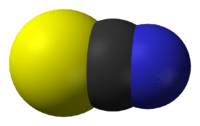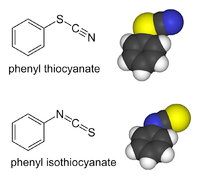Thiocyanate
 | |
| Names | |
|---|---|
| IUPAC name
cyanosulfanide | |
| Other names
sulfocyanate (sulphocyanate), thiocyanide | |
| Identifiers | |
| 302-04-5 | |
| 3D model (Jmol) | Interactive image |
| ChEBI | CHEBI:18022 |
| ChEMBL | ChEMBL84336 |
| ChemSpider | 8961 |
| 4529 | |
| PubChem | 9322 |
| |
| |
| Properties | |
| SCN- | |
| Molar mass | 58.0824 |
| Except where otherwise noted, data are given for materials in their standard state (at 25 °C [77 °F], 100 kPa). | |
| | |
| Infobox references | |
Thiocyanate (also known as rhodanide) is the anion [SCN]−. It is the conjugate base of thiocyanic acid. Common derivatives include the colourless salts potassium thiocyanate and sodium thiocyanate. Organic compounds containing the functional group SCN are also called thiocyanates. Mercury(II) thiocyanate was formerly used in pyrotechnics.
Thiocyanate is analogous to the cyanate ion, [OCN]−, wherein oxygen is replaced by sulfur. [SCN]− is one of the pseudohalides, due to the similarity of its reactions to that of halide ions. Thiocyanate used to be known as rhodanide (from a Greek word for rose) because of the red colour of its complexes with iron. Thiocyanate is produced by the reaction of elemental sulfur or thiosulfate with cyanide:
- 8 CN− + S8 → 8 SCN−
- CN− + S
2O2−
3 → SCN− + SO2−
3
The second reaction is catalyzed by the enzyme sulfotransferase known as rhodanase and may be relevant to detoxification of cyanide in the body.
Organic thiocyanates
Organic and transition metal derivatives of the thiocyanate ion can exist as "linkage isomers". In thiocyanates, the organic group (or metal ion) is attached to sulfur: R−S−C≡N has a S–C single bond and a C≡N triple bond.[1] In isothiocyanates, the substituent is attached to nitrogen: R−N=C=S has a S=C double bond and a C=N double bond:

Organic thiocyanates are valuable building blocks in organic chemistry and they allow to access efficiently various sulfur containing functional groups and scaffolds.[2]
Synthesis
Several synthesis routes exist, the most basic being the reaction between alkyl halides and alkali thiocyanate in aqueous media.[3] Organic thiocyanates are hydrolyzed to thiocarbamates in the Riemschneider thiocarbamate synthesis.
Biological chemistry of thiocyanate in medicine
Thiocyanate[4] is known to be an important part in the biosynthesis of hypothiocyanite by a lactoperoxidase.[5][6][7] Thus the complete absence of thiocyanate[8] or reduced thiocyanate[9] in the human body, (e.g., cystic fibrosis) is damaging to the human host defense system.[10][11]
Thiocyanate is a potent competitive inhibitor of the thyroid sodium-iodide symporter.[12] Iodine is an essential component of thyroxine. Since thiocyanates will decrease iodide transport into the thyroid follicular cell, they will decrease the amount of thyroxine produced by the thyroid gland. As such, foodstuffs containing thiocyanate are best avoided by hypothyroid patients.[13]
In the early 20th century, thiocyanate was used in the treatment of hypertension, but it is no longer used because of associated toxicity.[14] Sodium nitroprusside, a metabolite of which is thiocyanate, is however still used for the treatment of a hypertensive emergency. Rhodanese catalyzes the reaction of sodium nitroprusside with thiosulfate to form the metabolite thiocyanate.
Coordination chemistry
Resonance structures of the thiocyanate ion
|
Thiocyanate shares its negative charge approximately equally between sulfur and nitrogen. As a consequence, thiocyanate can act as a nucleophile at either sulfur or nitrogen — it is an ambidentate ligand. [SCN]− can also bridge two (M−SCN−M) or even three metals (>SCN− or −SCN<). Experimental evidence leads to the general conclusion that class A metals (hard acids) tend to form N-bonded thiocyanate complexes, whereas class B metals (soft acids) tend to form S-bonded thiocyanate complexes. Other factors, e.g. kinetics and solubility, are sometimes involved, and linkage isomerism can occur, for example [Co(NH3)5(NCS)]Cl2 and [Co(NH3)5(SCN)]Cl2.[15]

Test for iron(III) and cobalt(II)
If [SCN]− is added to a solution containing iron(III) ions (Fe3+), a blood red solution is formed due to the formation of [Fe(SCN)(H2O)5]2+.
-3D-balls.png) The blood-red coloured complex pentaaqua(thiocyanato-N)iron(III), [Fe(NCS)(H2O)5]2+, indicates the presence of Fe3+ in solution
The blood-red coloured complex pentaaqua(thiocyanato-N)iron(III), [Fe(NCS)(H2O)5]2+, indicates the presence of Fe3+ in solutioniron(III)_chloride.jpg) Iron(III) test
Iron(III) test
Similarly, Co2+ gives a blue complex with thiocyanate. Both the iron and cobalt complexes can be extracted into organic solvents like diethyl ether or amyl alcohol. This allows the determination of these ions even in strongly coloured solutions. The determination of Co(II) in the presence of Fe(III) is possible by adding KF (toxic!) to the solution, which forms uncoloured, very stable complexes with Fe(III), which no longer react with SCN−.
Phospholipids or some detergents aid the transfer of thiocyanatoiron into chlorinated solvents like chloroform and can be determined in this fashion.[17]
References
- ↑ Guy, R. G. (1977). "Syntheses and Preparative Applications of Thiocyanates". In Patai, S. Chemistry of Cyanates and Their Derivatives. 2. New York: John Wiley.
- ↑ Castanheiro, Thomas; Suffert, Jean; Donnard, Morgan; Gulea, Mihaela (2016-02-01). "Recent advances in the chemistry of organic thiocyanates". Chem. Soc. Rev. 45 (3): 494–505. doi:10.1039/c5cs00532a. ISSN 1460-4744.
- ↑ "Synthesis of thiocyanates".
- ↑ Pedemonte, N.; Caci, E.; Sondo, E.; Caputo, A.; Rhoden, K.; Pfeffer, U.; di Candia, M.; Bandettini, R.; Ravazzolo, R.; Zegarra-Moran, O.; Galietta, L. J. (2007). "Thiocyanate Transport in Resting and IL-4-Stimulated Human Bronchial Epithelial Cells: Role of Pendrin and Anion Channels" (pdf). Journal of Immunology. 178 (8): 5144–5153. doi:10.4049/jimmunol.178.8.5144. PMID 17404297.
- ↑ Conner, G. E.; Wijkstrom-Frei, C.; Randell, S. H.; Fernandez, V. E.; Salathe, M. (2007). "The Lactoperoxidase System Links Anion Transport to Host Defense in Cystic Fibrosis" (pdf). FEBS Letters. 581 (2): 271–278. doi:10.1016/j.febslet.2006.12.025. PMC 1851694
 . PMID 17204267.
. PMID 17204267. - ↑ White, W. E.; Pruitt, K. M.; Mansson-Rahemtulla, B. (1983). "Peroxidase-Thiocyanate-Peroxide Antibacterial System Does not Damage DNA" (pdf). Antimicrobial Agents and Chemotherapy. 23 (2): 267–272. doi:10.1128/aac.23.2.267. PMC 186035
 . PMID 6340603.
. PMID 6340603. - ↑ Thomas, E. L.; Aune, T. M. (1978). "Lactoperoxidase, Peroxide, Thiocyanate Antimicrobial System: Correlation of Sulfhydryl Oxidation with Antimicrobial Action" (pdf). Infection and Immunity. 20 (2): 456–463. PMC 421877
 . PMID 352945.
. PMID 352945. - ↑ Childers, M.; Eckel, G.; Himmel, A.; Caldwell, J. (2007). "A new Model of Cystic Fibrosis Pathology: Lack of Transport of Glutathione and its Thiocyanate Conjugates". Medical Hypotheses. 68 (1): 101–112. doi:10.1016/j.mehy.2006.06.020. PMID 16934416.
- ↑ Minarowski, Ł.; Sands, D.; Minarowska, A.; Karwowska, A.; Sulewska, A.; Gacko, M.; Chyczewska, E. (2008). "Thiocyanate concentration in saliva of cystic fibrosis patients" (pdf). Folia Histochemica et Cytobiologica. 46 (2): 245–246. doi:10.2478/v10042-008-0037-0. PMID 18519245.
- ↑ Moskwa, P.; Lorentzen, D.; Excoffon, K. J.; Zabner, J.; McCray, P. B. Jr.; Nauseef, W. M.; Dupuy, C.; Bánfi, B. (2007). "A Novel Host Defense System of Airways is Defective in Cystic Fibrosis" (pdf). American Journal of Respiratory and Critical Care Medicine. 175 (2): 174–183. doi:10.1164/rccm.200607-1029OC. PMC 2720149
 . PMID 17082494.
. PMID 17082494. - ↑ Xu, Y.; Szép, S.; Lu, Z.; Szep; Lu (2009). "The antioxidant role of thiocyanate in the pathogenesis of cystic fibrosis and other inflammation-related diseases" (pdf). Proceedings of the National Academy of Sciences of the United States of America. 106 (48): 20515–20519. Bibcode:2009PNAS..10620515X. doi:10.1073/pnas.0911412106. PMC 2777967
 . PMID 19918082.
. PMID 19918082. - ↑ Braverman L. E.; He X.; Pino S.; et al. (2005). "The effect of perchlorate, thiocyanate, and nitrate on thyroid function in workers exposed to perchlorate long-term". J Clin Endocrinol Metab. 90 (2): 700–706. doi:10.1210/jc.2004-1821. PMID 15572417.
- ↑ "Hypothyroidism". umm.edu. University of Maryland Medical Center. Retrieved 3 December 2014.
- ↑ Warren F. Gorman; Emanuel Messinger; And Morris Herman (1949). "Toxicity of Thiocyanates Used in Treatment of Hypertension". Ann Intern Med. 30 (5): 1054–1059. doi:10.7326/0003-4819-30-5-1054.
- ↑ Greenwood, Norman N.; Earnshaw, Alan (1997). Chemistry of the Elements (2nd ed.). Butterworth-Heinemann. p. 326. ISBN 0-08-037941-9.
- ↑ Gus J. Palenik, George Raymond Clark "Crystal and Molecular Structure of Isothiocyanatothiocyanato-(1-diphenylphosphino-3-dimethylaminopropane)palladium(II)" Inorganic Chemistry, 1970, volume 9, pp 2754–2760. doi:10.1021/ic50094a028
- ↑ Stewart, J.C. (1980). "Colorimetric determination of phospholipids with ammonium ferrothiocyanate". Anal. Biochem. 104: 10–14. doi:10.1016/0003-2697(80)90269-9.